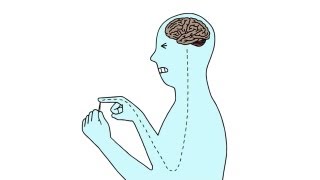(单词翻译:单击)
Say you're at the beach, and you get sand in your eyes. How do you know the sand is there?
假设你在海滩上,沙子进了眼睛,你怎么知道有沙子呢?
You obviously can't see it, but if you are a normal, healthy human,
显然你看不到,但若你是个正常、健康的人,
you can feel it, that sensation of extreme discomfort, also known as pain.
你可以感觉到有沙子,这种极不舒服的感觉叫做“疼痛”。
Now, pain makes you do something, in this case, rinse your eyes until the sand is gone.
疼痛要你采取行动,此例中是要你冲洗眼睛,直到沙子消失。
And how do you know the sand is gone? Exactly. Because there's no more pain.
你怎么知道沙子不见了?没错,因为不痛了。
There are people who don't feel pain.
有人感觉不到疼痛。
Now, that might sound cool, but it's not.
听起来很酷,但其实一点也不酷。
If you can't feel pain, you could get hurt, or even hurt yourself and never know it.
如果感觉不到疼痛,你可能会受伤,甚至完全不知道可能会伤到自己。
Pain is your body's early warning system.
疼痛是你身体的早期预警系统。
It protects you from the world around you, and from yourself.
它可以保护你不受到周围世界或自己的伤害。
As we grow, we install pain detectors in most areas of our body.
随着我们长大,疼痛传感器会安装在身体的大多数地方。
These detectors are specialized nerve cells called nociceptors
这些传感器是特殊的神经细胞,称为“痛觉感受器”,
that stretch from your spinal cord to your skin, your muscles, your joints, your teeth and some of your internal organs.
分布在脊髓、皮肤、肌肉、关节、牙齿和一些内脏。
Just like all nerve cells, they conduct electrical signals,
就像所有的神经细胞一样,它们用电传送信号,
sending information from wherever they're located back to your brain.
从它们所在之处送讯号回大脑。
But, unlike other nerve cells, nociceptors only fire if something happens that could cause or is causing damage.
不像其他神经细胞,痛觉感受器只在可能或正在造成伤害时才会作用。
So, gently touch the tip of a needle. You'll feel the metal, and those are your regular nerve cells.
所以,轻摸针尖。你可以感觉到金属,一般神经细胞会给你这种感觉。
But you won't feel any pain.
不会感到任何疼痛。
Now, the harder you push against the needle, the closer you get to the nociceptor threshold.
但你越用力推针尖,越接近痛觉感受器的阈值。
Push hard enough, and you'll cross that threshold and the nociceptors fire,
很用力的话,就会超过阈值,痛觉感受器启动,
telling your body to stop doing whatever you're doing.
告诉身体停止目前的行为。

But the pain threshold isn't set in stone.
痛觉感受器的阈值并非一成不变。
Certain chemicals can tune nociceptors, lowering their threshold for pain.
某些化学物质可以调节感受器,降低痛觉的阈值。
When cells are damaged, they and other nearby cells start producing these tuning chemicals like crazy,
细胞受损时,受损细胞及邻近细胞开始疯狂生产这些调节化学物质,
lowering the nociceptors' threshold to the point where just touch can cause pain.
降低痛觉感受器的阈值,直到连触摸都会疼痛。
And this is where over-the-counter painkillers come in.
这时非处方的止痛药可以大展身手了。
Aspirin and ibuprofen block production of one class of these tuning chemicals, called prostaglandins.
阿司匹林和布洛芬可阻止一种调节化学物质的生产,称为“前列腺素”。
Let's take a look at how they do that.
我们来探讨一下原理.
When cells are damaged, they release a chemical called arachidonic acid.
当细胞损伤,会释放一种化学物质,叫做“花生油酸”。
And two enzymes called COX-1 and COX-2 convert this arachidonic acid into prostaglandin H2,
有两种酵素,COX-1和 COX-2,可将花生油酸转换成前列腺素H2,
which is then converted into a bunch of other chemicals that do a bunch of things,
再将其转换成一系列化学物质,产生一连串效果
including raise your body temperature, cause inflammation and lower the pain threshold.
包括升高体温、引起发炎、降低疼痛阈值。
Now, all enzymes have an active site. That's the place in the enzyme where the reaction happens.
所有的酵素有特定的活性部位,也就是酵素反应发生的地方。
The active sites of COX-1 and COX-2 fit arachidonic acid very cozily.
COX-1和COX-2的活性部位非常适合花生油酸。
As you can see, there is no room to spare.
正如你看到的,这里也没有多余的空间。
Now, it's in this active site that aspirin and ibuprofen do their work.
阿司匹林和布洛芬,就是在这个活性部位发挥作用。
So, they work differently. Aspirin acts like a spine from a porcupine.
它们的工作原理不同:阿司匹林像豪猪的刺。
It enters the active site and then breaks off, leaving half of itself in there,
它进入活性部位,然后脱落,留下一半在那里,
totally blocking that channel and making it impossible for the arachidonic acid to fit.
完全阻断通道,让花生油酸进不来。
This permanently deactivates COX-1 and COX-2.
永久停用COX-1和COX-2。
Ibuprofen, on the other hand, enters the active site, but doesn't break apart or change the enzyme.
另一方面,布洛芬进入活性部位,但不破坏或改变酵素。
COX-1 and COX-2 are free to spit it out again, but for the time that that ibuprofen is in there,
COX-1和COX-2可把它再吐出来,但布洛芬在那里的期间,
the enzyme can't bind arachidonic acid, and can't do its normal chemistry.
酵素无法结合花生油酸,因此无法进行正常的化学反应。
But how do aspirin and ibuprofen know where the pain is? Well, they don't.
阿司匹林和布洛芬怎么知道哪里痛?噢,它们并不知道。
Once the drugs are in your bloodstream, they are carried throughout your body,
一旦药物进入血液中,就会被带往全身
and they go to painful areas just the same as normal ones.
不但会到疼痛部位,也会到正常部位。
So that's how aspirin and ibuprofen work. But there are other dimensions to pain.
这就是阿司匹林和布洛芬的原理,还有其他种类的疼痛。
Neuropathic pain, for example, is pain caused by damage to our nervous system itself;
例如神经性疼痛是神经系统本身受损所引起的疼痛,
there doesn't need to be any sort of outside stimulus.
不需要任何形式的外界刺激。
And scientists are discovering that the brain controls how we respond to pain signals.
科学家们发现,大脑控制了我们对疼痛信号的反应。
For example, how much pain you feel can depend on whether you're paying attention to the pain, or even your mood.
例如,疼痛的程度取决于你对疼痛的在意程度,甚至是你的心情。
Pain is an area of active research.
疼痛是个活跃的研究领域。
If we can understand it better, maybe we can help people manage it better.
如果能更了解疼痛,或许就更能有效的管理疼痛。


